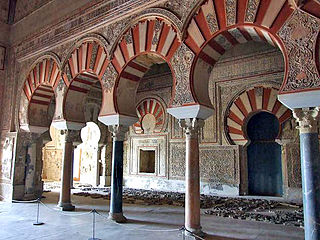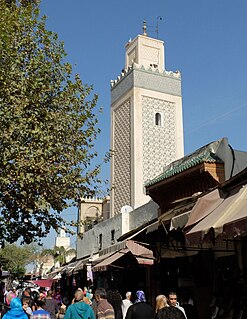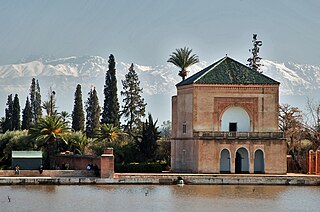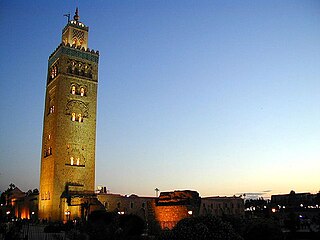
Dar Moulay Ali is a historic residence and riad in Marrakesh, Morocco. It is located right next to the Kutubiyya Mosque. It currently houses the French consulate.

Dar Moulay Ali is a historic residence and riad in Marrakesh, Morocco. It is located right next to the Kutubiyya Mosque. It currently houses the French consulate.
The residence was built in the 1820s, during the reign of Sultan Moulay Abd ar-Rahman, by Sulayman as-Siyadmi, a qaid of the Chiadma tribe. Moulay Abd ar-Rahman's son and successor, Muhammad IV, confiscated the residence and gifted it to his brother Ali (Moulay Ali), after whom the residence is now named. During the French Protectorate in Morocco (1912-1956), it was used as the residence of various military officials. Today it remains in use as the official office and residence of the French consulate. The building was most recently restored in 2015. [1] [2] [3] [4]

The residence is located directly east of the Kutubiyya Mosque, between the mosque and the main road today. It consists of a large house centered around a small courtyard garden, off which ornate salons opened. The house was decorated with painted arabesque motifs, zellij tilework, and epigraphic Arabic inscriptions. An imposing menzeh or viewing pavilion originally stood on its southwestern side, next to the mosque, but this was demolished in the 1920s. The residence's original main entrance was on its northeast side, where a large rectangular riad garden (a garden divided into four parts by two crossing paths, with a central fountain at the intersection of the paths) led up to a decorated porch in front of the entrance doorway. The riad garden had two small outer entrances on its east side but the main entrance to the compound was through another courtyard on its south side. This courtyard and the riad garden, however, were mostly demolished in the 20th century when the main road on its east side was enlarged, although traces of it have been preserved and can be seen outside the present-day walls of the residence. An even larger garden park was stretched out on the south side of the residence and still exists today. [3] [2]

The Kutubiyya Mosque or Koutoubia Mosque is the largest mosque in Marrakesh, Morocco. The mosque's name is also variably rendered as Jami' al-Kutubiyah, Kutubiya Mosque, Kutubiyyin Mosque, and Mosque of the Booksellers. It is located in the southwest medina quarter of Marrakesh, near the famous public place of Jemaa el-Fna, and is flanked by large gardens.

The Bahia Palace is a late 19th-century palace in Marrakesh, Morocco. The palace was first begun by Si Musa, grand vizier of Alaouite sultan Muhammad ibn Abd al-Rahman, in 1859 and then continued and expanded by his son Si Ba Ahmed ibn Musa, grand vizier of Sultan Moulay Abdelaziz between 1894 and 1900. Today it is a well-known historic monument and tourist attraction in the city.

The Museum of Marrakech is a historic palace and museum located in the old center of Marrakesh, Morocco. In addition to its notable architecture, the museum's collection showcases various historic art objects and contemporary art from Morocco.

Madinat al-Zahra or Medina Azahara was a fortified palace-city on the western outskirts of Córdoba in present-day Spain. Its remains are a major archaeological site today. The city was built in the 10th century by Abd-ar-Rahman III (912–961), a member of the Umayyad dynasty and the first caliph of Al-Andalus. It served as the capital of the Caliphate of Córdoba and its center of government.

El Badi Palace or Badi' Palace is a ruined palace located in Marrakesh, Morocco. It was commissioned by the sultan Ahmad al-Mansur of the Saadian dynasty a few months after his accession in 1578, with construction and embellishment continuing throughout most of his reign. The palace, decorated with materials imported from numerous countries ranging from Italy to Mali, was used for receptions and designed to showcase the Sultan's wealth and power. It was one part of a larger Saadian palace complex occupying the Kasbah district of Marrakesh.

Fes Jdid or Fes el-Jdid is one of the three parts of Fez, Morocco. It was founded by the Marinids in 1276 as an extension of Fes el Bali and as a royal citadel and capital. It is occupied in large part by the historic Royal Palace, which was once the center of government in Morocco and which is still used on occasion by the King of Morocco today. The district also contains the historic Mellah of the city. Since 1981 it has been classified, along with Fes el-Bali, as a UNESCO World Heritage Site.

The Menara Gardens are a historic public garden and orchard in Marrakech, Morocco. They were established in the 12th century by the Almohad Caliphate ruler Abd al-Mu'min. Along with the Agdal Gardens and the historic walled city of Marrakesh, the gardens have been listed as UNESCO World Heritage Site since 1985. The gardens are laid out around a central water basin and reservoir, next to which is a pleasure pavilion dating in its current form from the 19th century. The reservoir and its pavilion, often framed in pictures against the background of the High Atlas Mountains to the south, are considered one of the iconic views and symbols of Marrakesh.

This article contains notable landmarks of the city of Marrakesh, Morocco.

The Zawiya of Moulay Idris II is a zawiya in Fez, Morocco. It contains the tomb of Idris II, who ruled Morocco from 807 to 828 and is considered the main founder of the city of Fez. It is located in the heart of Fes el-Bali, the UNESCO-listed old medina of Fez, and is considered one of the holiest shrines in Morocco.

The Ben Youssef Mosque, is a mosque in the Medina quarter of Marrakesh, Morocco, named after the Almoravid emir Ali ibn Yusuf. It is arguably the oldest and most important mosque in Marrakesh.

The Kasbah Mosque is a historic mosque in Marrakesh, Morocco. It was originally built by the Almohad caliph Yaqub al-Mansour in 1185-1190 CE. It is located in the Kasbah district, the city's former citadel, near the site of its historic royal palaces. Along with the Kutubiyya Mosque, it is one of the most important historic mosques in Marrakesh.

Dar Batḥa, or Qasr al-Batḥa, is a former royal palace in the city of Fez, Morocco. The palace was commissioned by the Alaouite Sultan Hassan I in the late 19th century and finished under his successor Abdelaziz. It was converted into a museum of historical arts and crafts in 1915 with a collection that now comprises over 6,500 objects. The palace is located near Bab Bou Jeloud at the western edge of Fes el-Bali, the old medina quarter of the city, and close to Fes el-Jdid, the new medina quarter.

The Dar al-Makhzen or Royal Palace of Fez is the royal palace of the King of Morocco in the city of Fez, Morocco. Its original foundation dates back to the foundation of Fes el-Jdid, the royal citadel of the Marinid dynasty, in 1276 CE. Most of the palace today dates from the Alaouite era. The vast grounds are home to multiple private structures, patios, and gardens, but historically also included administrative offices and government tribunals. Today, the most publicly visible parts of the palace are its main entrances at the Old Mechouar and the highly ornate 20th-century gates at Place des Alaouites, near the Mellah.

The architecture of Fez, Morocco, reflects the wider trends of Moroccan architecture dating from the city's foundation in the late 8th century and up to modern times. The old city (medina) of Fes, consisting of Fes el-Bali and Fes el-Jdid, is notable for being an exceptionally well-preserved medieval North African city and is classified as a UNESCO World Heritage Site. A large number of historic monuments from different periods still exist in it today, including mosques, madrasas, synagogues, hammams (bathhouses), souqs (markets), funduqs (caravanserais), defensive walls, city gates, historic houses, and palaces.

The Lalla Aouda Mosque or Mosque of Lalla 'Awda is a large historic mosque in Meknes, Morocco. It was originally the mosque of the Marinid kasbah (citadel) of the city, built in 1276, but was subsequently remodeled into the royal mosque of the Alaouite sultan Moulay Isma'il's imperial palace in the late 17th century.

The Zawiya of Sidi Muhammad Ben Sliman al-Jazuli is an Islamic religious complex (zawiya) in Marrakesh, Morocco. It is centered around the tomb of the 15th-century Muslim scholar and Sufi saint Muhammad al-Jazuli, who is one of the Seven Saints of Marrakesh.

The Kasbah of Marrakesh is a large walled district in the southern part of the medina of Marrakesh, Morocco, which historically served as the citadel (kasbah) and royal palace complex of the city. A large part of the district is still occupied by the official royal palace, the Dar al-Makhzen, which serves as the residence of the King of Morocco when he visits the city. The rest of the district consists of various neighbourhoods and monuments. It was built in the late 12th century under the Almohads, during the reign of Caliph Ya'qub al-Mansur. The Kasbah Mosque, and the main public gate, Bab Agnaou, were built in the 12th century as well.

The Walls of Marrakesh are a set of defensive ramparts which enclose the historic medina districts of Marrakesh, Morocco. They were first laid out in the early 12th century by the Almoravid dynasty which founded the city in 1070 CE as their new capital. The walls have since been expanded several times by the addition of the Kasbah to the south at the end of the 12th century and by the later extension of the walls to encompass the neighbourhood around the Zawiya of Sidi Bel Abbes.

The Kasbah of Moulay Ismail is a vast palace complex and royal kasbah (citadel) built by the Moroccan sultan Moulay Isma'il ibn Sharif in Meknes, Morocco. It is also known, among other names, as the Imperial City or Palaceof Moulay Ismail, or the Kasbah of Meknes. It was built by Moulay Isma'il over the many decades of his reign between 1672 and 1727, when he made Meknes the capital of Morocco, and received occasional additions under later sultans.

The Mausoleum of Moulay Isma'il is a historic Islamic funerary complex in Meknes, Morocco. It contains the tomb of Sultan Moulay Isma'il, who ruled Morocco from 1672 until his death in 1727, and is located inside his former Kasbah (citadel). It is a major historic and religious site in the city.
| Wikimedia Commons has media related to Dar Moulay Ali . |
Coordinates: 31°37′25.9″N7°59′33.5″W / 31.623861°N 7.992639°W